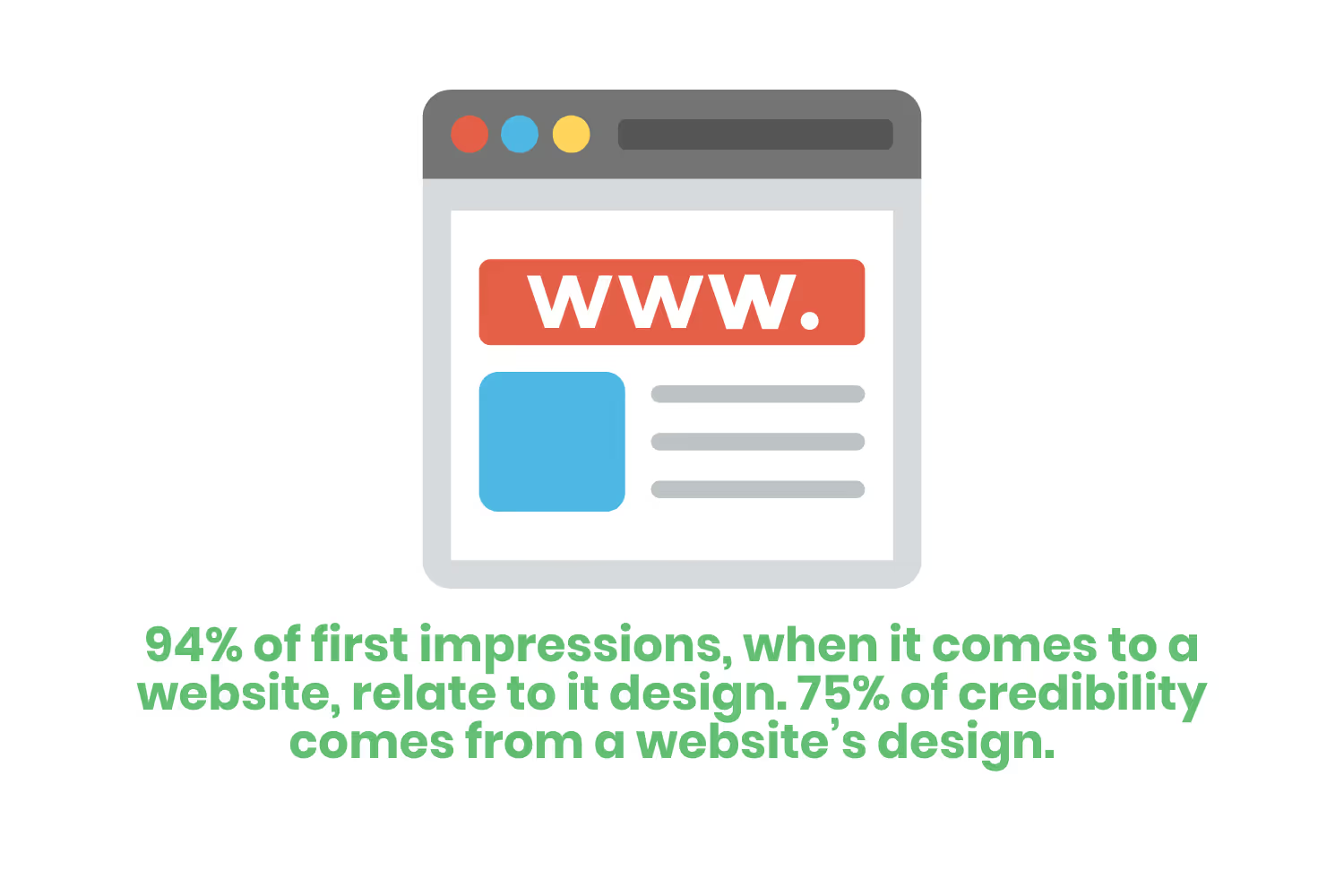6 Essential Website Design Tips for Therapists
Many details go into creating a high-quality business website, and competition for potential clients is fierce. When people shop around for any kind of service, they do so visually first. That fact still rings true if you’re a therapist. So let’s get started.

Did you know that 94% of first impressions when it comes to a website relate to its design? On top of that, 75% of credibility comes from a website’s design. So if you take anything from these statistics, it’s that if you run a business, your website should be high-quality.
Now I’m sure you’re thinking, “Wait, I thought this was about websites for therapists? Not for commerce businesses.” And you’re right! But just because you practice in the healthcare sector, doesn’t mean that you are immune to the buyer’s market.

To grow your patient base, you have to advertise and stay competitive in your field. That means that no matter what your practice is, you need to have a website to stay relevant in today’s digital world.
Many details go into creating a high-quality business website, and competition for potential clients is fierce. When people shop around for any kind of service, they do so visually first. So let’s get started.
The Benefits of a Website for Your Practice
Having your own website as a therapist helps you establish yourself both online and within the professional community. Patients and doctors looking for referrals browse the web when they are in need of therapy services, or simply want more information. Put yourself in a position where you are accessible to a broader audience by investing in a website!
Providing valuable information on your site about your services, credentials, and more can help you grow your clientele quickly and efficiently. Having potential clients learn more about you and your services before scheduling an appointment increases the likelihood of a good fit - which ultimately leads to more patients returning after the initial appointment.
Websites can also cater to those searching for online therapy services. Whether the patient has a busy schedule, doesn’t have the means for transportation, or just feels more comfortable with online therapy, you want to offer choices when it comes to your services if you want to reach a larger potential client base.
Important Website Elements
At the end of the day, your online presence offers a cost-effective way for you to advertise your services. A well-designed website will enhance your reliability and show that you are serious about your practice. Let’s look at a few important factors to consider when creating your own website.
Images
Images have the power to convey not only information but emotion as well. Because of this, some people say that pictures have a greater psychological impact than words. After all, emotions are a driving force in how we interact with our environment and the decisions we make. Images and art subtly influence the human mind every day, so why not take advantage of it?
As a therapist, you want to convey to your potential clients that your practice is a safe space. Images on your website that communicate empathy and understanding will reassure clients that they can expect a pleasant experience. This can look like a picture of a therapist listening intently and images of your office and staff. Make sure when showing off your workplace, you find a good balance between professionalism and a warm and inviting environment.
Many therapist websites show pictures of people who are sad, which might seem like an appropriate choice given the nature of the job, but can turn away potential clients. Displaying positive and bright images that give a sense of hope can speak to what your services offer to a person in turmoil.

A hero image is the first thing visitors see when they land on your homepage and sets the tone for the rest of your website. Consider making your hero image something that plays on these positive and hopeful themes. Leaving an impactful first impression means those perusing your site are more likely to stay and take a look around.
Note that alt text descriptions for each image are an important feature to include for those who are visually impaired. Your images should help to convey your brand’s values, goals, and overall personality.
Videos
Similar to images, but they move. Yes, we are talking about including videos in your website design! Stay competitive with other therapists by incorporating videos for a more engaging experience. You can use videos to introduce yourself and your team. This adds a personal touch to your site, helping potential clients feel more comfortable and willing to reach out to you for help.
Adding some educational content through this media can also showcase your knowledge. Showcasing your expertise by sharing content about mental health, therapeutic techniques, and coping strategies gives your patients a glimpse of what to expect during sessions.

The unknown can be scary, so why not let people see a small preview of what they can expect from you? This will not only bring patients in the door but will prevent them from leaving after the first session. This is because they come in already interested in what you offer and specialize in. Transparency between provider and patient in the mental health space is key.
Did you know that by including videos on your site, you can boost your Search Engine Optimization (SEO)? This means that your site can become easily findable, more relevant and likely to pop up on a search engine. This can improve your website’s organic traffic, so there is less need to spend your money on pay-per-click advertising.
Speaking of advertising, just providing the ability for people to share your videos through social media is another awesome way to tap into some free advertisement!
Colors
Similar to images, color has a profound effect on the human psyche. It is also one of the first things that a visitor notices when they land on your website. Colors set the tone and can influence a person’s interest in your practice without them even knowing what you offer.
You want your color scheme to exude a sense that you offer a calm, professional, and trustworthy practice. Here are some examples of what certain colors might convey to your online visitors:
- Green: Nature, health, vitality.
- Red: Passion, love, anger, power.
- Blue: Calming, sadness, professionalism.
- Purple: Luxury/royalty, ambition, mystery.
- Orange: Warmth, happiness, emotional wellness.
- Yellow: Energizing, positive, fun.
- Pink: Playful, soft, kind.
- Black: Sophistication, grief, rebelliousness.
- White: Purity, innocence, safety, cleanliness.
- Brown: Comfort, organic, approachable.
By carefully selecting and creating a color scheme, you can subconsciously communicate your values to a potential client. You can also establish yourself amongst your competition by selecting the right colors for your logo.
As consumers, we recognize popular brands immediately by the color and shape of their logos. Think of the bold red of Coca-Cola or the golden arches of McDonald’s. When someone thinks of therapy, you want your brand to pop into their mind first!
Fonts
Sticking with the theme of perfecting the overall vibe and feel of your website, we are going to talk about fonts. It might seem silly and trivial, but the right font choice can be just as effective as the right color scheme or images!
Fonts can reflect your values and give your website personality. For example, a more modern and clean font such as Times New Roman might communicate professionalism. In contrast, a handwritten font such as Sans Serif delivers a more playful and informal appearance.

Making sure your fonts are legible, however, should be your top priority. People are visiting your website to gather information. So if they can’t read anything, this will only frustrate a potential client and drive them away. Consider staying away from small cursive fonts that tend to bleed words together.
Also, try not to use too many different kinds of fonts throughout your website. This helps reinforce brand identity as well as makes your website look uniform and put together.
Strong/Clear Messaging
Here’s an easy recommendation to remember when it comes to website design: have clear messaging. Readers need to know exactly what you are offering after they land on your homepage. If you have a cluttered site that doesn’t get straight to the point, visitors are likely to leave just as fast as they arrived.
Explain first and foremost the type of therapy you offer. Talk about things like the benefits of therapy, how long you have been in practice, and if you take insurance. Also, be sure to include a way to contact you on that home page!
Make Contacting You Easy
Speaking of having a way to contact you, you’re going to want to listen up here. For many it is difficult to admit needing help, let alone actually go through with contacting someone about it. With this in mind, you should make it as seamless and straightforward to get a hold of your office as possible.

Putting a phone number at the top of the homepage where visitors can “click to call” makes it easy for a potential client to reach out. Especially if this person is viewing your site on a cell phone. This way they won’t have to write down or memorize the number while switching to their dial screen.
Another button to include is one that takes a client to a portal where they can schedule an appointment online. Some people might feel too anxious to speak to someone on the phone, and that’s ok! Just make sure your website meets the criteria to stay HIPAA compliant.
Conclusion
In order to provide quality mental health services, prioritize making yourself accessible to as many potential patients as possible. This means providing different avenues of communication such as calling or scheduling an appointment online through your.
Having a well-designed website can open the door to many opportunities for providers and businesses alike. It can establish your name amongst your competitors, highlight your credibility, and help streamline communication with your clients.
Emphasize your product's unique features or benefits to differentiate it from competitors
In nec dictum adipiscing pharetra enim etiam scelerisque dolor purus ipsum egestas cursus vulputate arcu egestas ut eu sed mollis consectetur mattis pharetra curabitur et maecenas in mattis fames consectetur ipsum quis risus mauris aliquam ornare nisl purus at ipsum nulla accumsan consectetur vestibulum suspendisse aliquam condimentum scelerisque lacinia pellentesque vestibulum condimentum turpis ligula pharetra dictum sapien facilisis sapien at sagittis et cursus congue.
- Pharetra curabitur et maecenas in mattis fames consectetur ipsum quis risus.
- Justo urna nisi auctor consequat consectetur dolor lectus blandit.
- Eget egestas volutpat lacinia vestibulum vitae mattis hendrerit.
- Ornare elit odio tellus orci bibendum dictum id sem congue enim amet diam.
Incorporate statistics or specific numbers to highlight the effectiveness or popularity of your offering
Convallis pellentesque ullamcorper sapien sed tristique fermentum proin amet quam tincidunt feugiat vitae neque quisque odio ut pellentesque ac mauris eget lectus. Pretium arcu turpis lacus sapien sit at eu sapien duis magna nunc nibh nam non ut nibh ultrices ultrices elementum egestas enim nisl sed cursus pellentesque sit dignissim enim euismod sit et convallis sed pelis viverra quam at nisl sit pharetra enim nisl nec vestibulum posuere in volutpat sed blandit neque risus.

Use time-sensitive language to encourage immediate action, such as "Limited Time Offer
Feugiat vitae neque quisque odio ut pellentesque ac mauris eget lectus. Pretium arcu turpis lacus sapien sit at eu sapien duis magna nunc nibh nam non ut nibh ultrices ultrices elementum egestas enim nisl sed cursus pellentesque sit dignissim enim euismod sit et convallis sed pelis viverra quam at nisl sit pharetra enim nisl nec vestibulum posuere in volutpat sed blandit neque risus.
- Pharetra curabitur et maecenas in mattis fames consectetur ipsum quis risus.
- Justo urna nisi auctor consequat consectetur dolor lectus blandit.
- Eget egestas volutpat lacinia vestibulum vitae mattis hendrerit.
- Ornare elit odio tellus orci bibendum dictum id sem congue enim amet diam.
Address customer pain points directly by showing how your product solves their problems
Feugiat vitae neque quisque odio ut pellentesque ac mauris eget lectus. Pretium arcu turpis lacus sapien sit at eu sapien duis magna nunc nibh nam non ut nibh ultrices ultrices elementum egestas enim nisl sed cursus pellentesque sit dignissim enim euismod sit et convallis sed pelis viverra quam at nisl sit pharetra enim nisl nec vestibulum posuere in volutpat sed blandit neque risus.
Vel etiam vel amet aenean eget in habitasse nunc duis tellus sem turpis risus aliquam ac volutpat tellus eu faucibus ullamcorper.
Tailor titles to your ideal customer segment using phrases like "Designed for Busy Professionals
Sed pretium id nibh id sit felis vitae volutpat volutpat adipiscing at sodales neque lectus mi phasellus commodo at elit suspendisse ornare faucibus lectus purus viverra in nec aliquet commodo et sed sed nisi tempor mi pellentesque arcu viverra pretium duis enim vulputate dignissim etiam ultrices vitae neque urna proin nibh diam turpis augue lacus.




